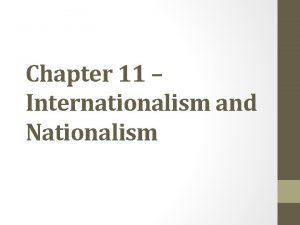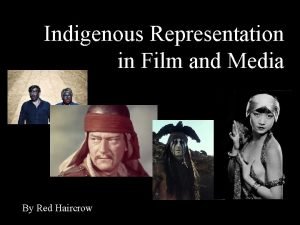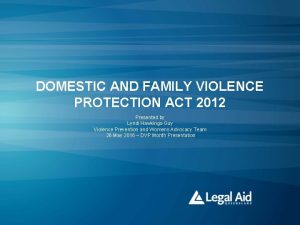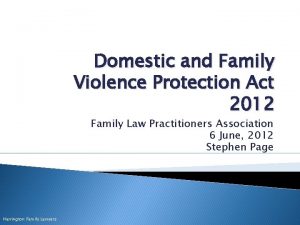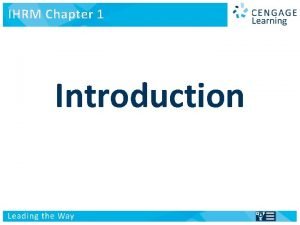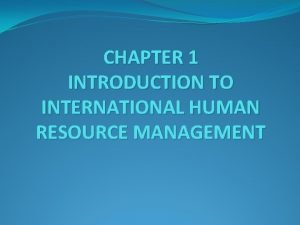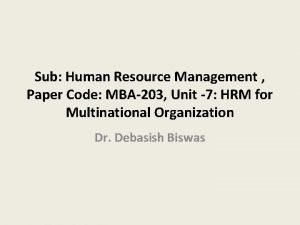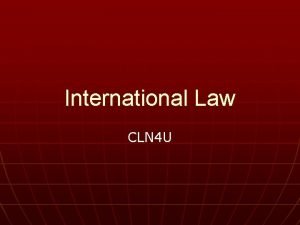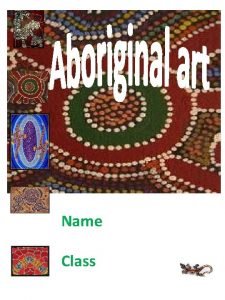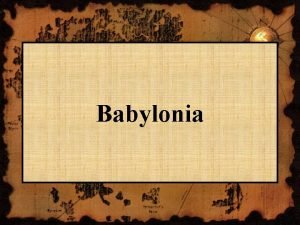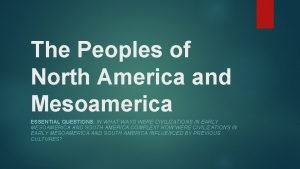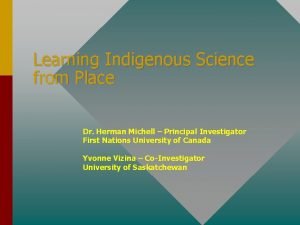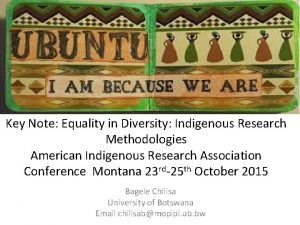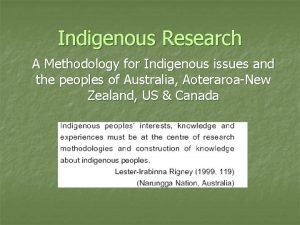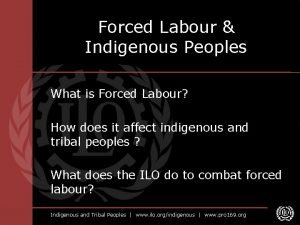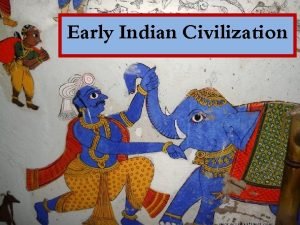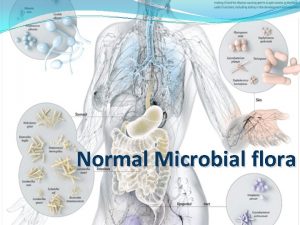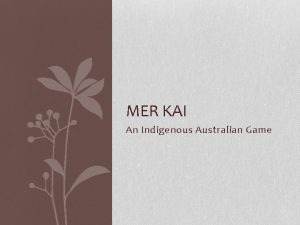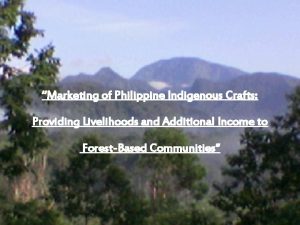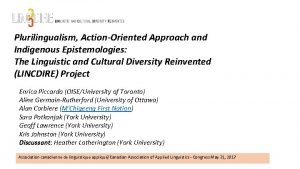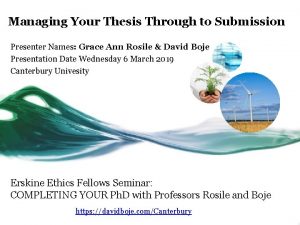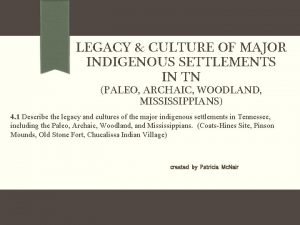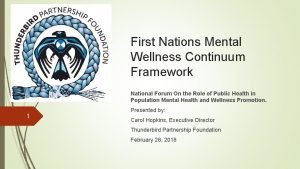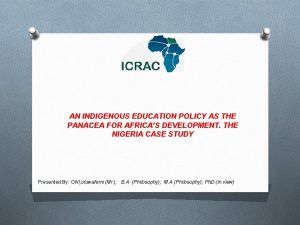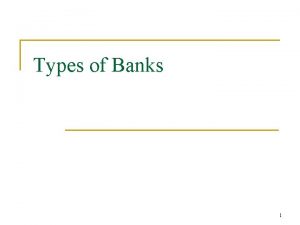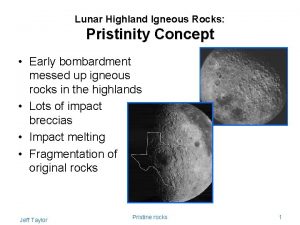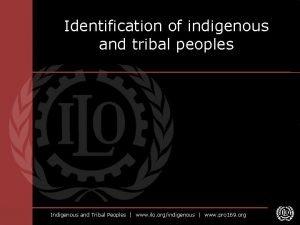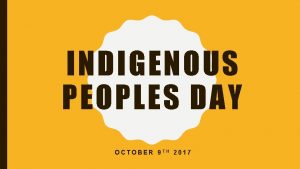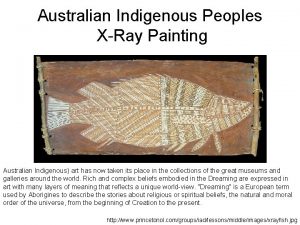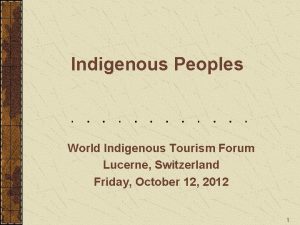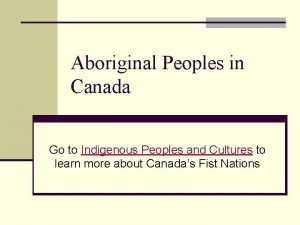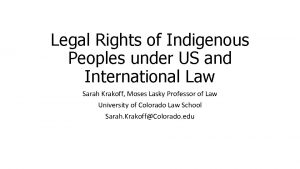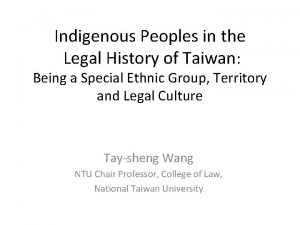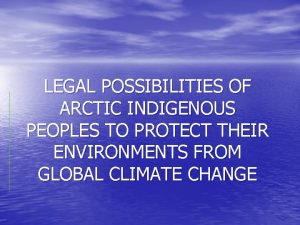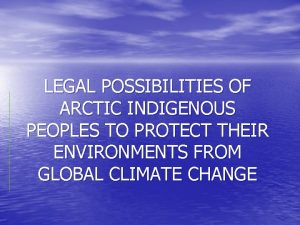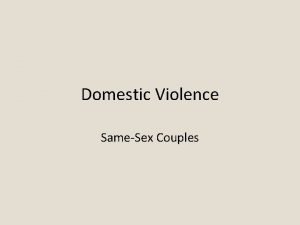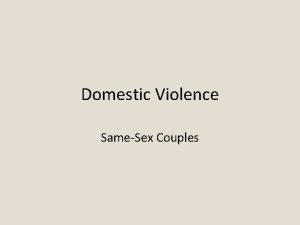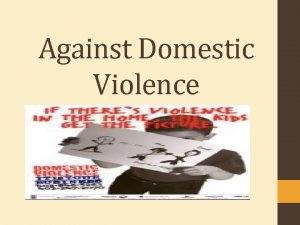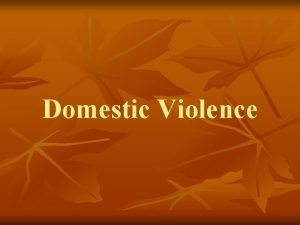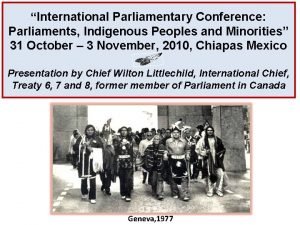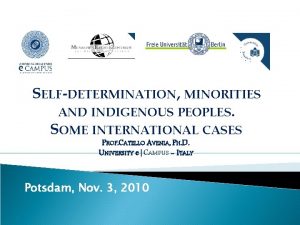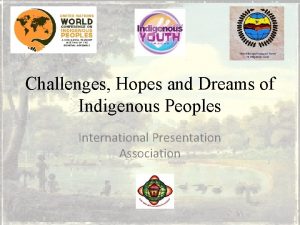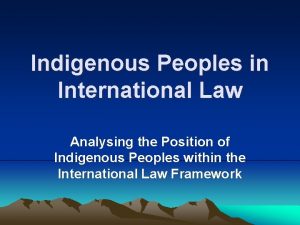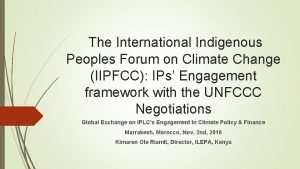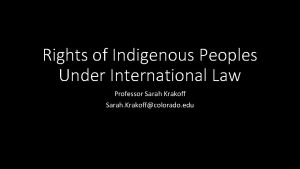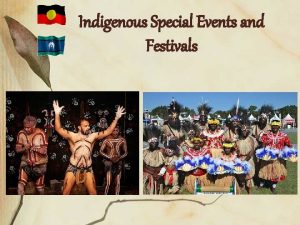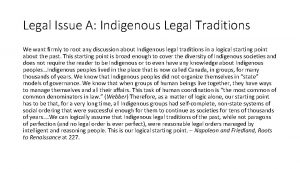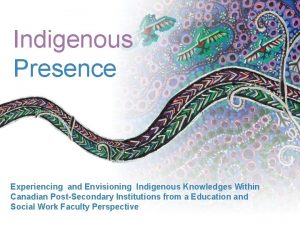International Legal and Domestic Protection of Indigenous Peoples










































- Slides: 42

International Legal and Domestic Protection of Indigenous Peoples’ Rights in the US and Russia Ruslan Garipov Kazan Federal (Volga Region) University 2012

Urgency of Indigenous Peoples’ Rights Protection 1. A lot of Indigenous Peoples are still disappearing; 2. Very low level of living standards among Indigenous Peoples; 3. Natural Environment Dependence of Indigenous Peoples; 4. In some countries there is still the process of colonization going on.

International level: • The assimilation Policy was replaced by Self-Determination (officially); • Indigenous People have a vital role in environmental management and development (UN Declaration on Environment and Development, 1992); • UN Declaration on Indigenous Peoples Rights, 2007. Domestic level: • Apologies were given by Australia and Canada to aborigines in 2008; • New Constitution in Bolivia, 2009.

Definition of «Indigenous People» . Synonyms: Characteristics of Indigenous People Identification • Indigenous People; 1. Historical connection with the land; • Aborigines; 2. Aboriginal Self-Consciousness; • First Nation; 3. Different culture, language and so on; • Native People; 4. Desire to keep it all for future existence • Autochthonic Population. as a Nation. There approximately 90 states where indigenous peoples live.

Evolution and Recognition of Indigenous Peoples’ Rights at the International Level. 1. 2. 3. 4. 5. 6. 7. Doctrine of Discovery (Terra Nullius approach); ILO Convention # 107, 1957 (first intl. act); ILO Convention # 169, 1989 (from Population to People); International year of Indigenous People – 1993; Two International Decades: 1995 -2004; 2005 -2014; UN PFII, 2002 UN Declaration on Indigenous Peoples’ Rights, 2007. • • • ILO Convention # 107 (definition of Indigenous Population); Statute of the ICJ (article 38); Doctrine of Domestic Dependant Nations.

Conventional Regulation of Indigenous Peoples’ Rights Protection • United Nations Charter, 1945 (Peoples’ Equality and Self-Determination Right); • International Covenant on Civil and Political Rights, 1966 (article 1, 27); • International Convention on the Elimination of All Forms of Racial Discrimination, 1966; • Convention on the Rights of the Child, 1989 (article 30); • Convention on Biological Diversity, 1992 (Preamble); • ILO Convention # 107, 1957 (18 states participant); • ILO Convention # 169, 1989 (22 states ratified).

The United Nations Declaration on Indigenous Peoples Rights and Its Role for Aborigines’ Rights Protection • In 1982 WGIP started the discussion on the Draft Declaration; • In 2007 the Declaration was adopted by the UN GA (4 states voted against: Australia, Canada, New Zealand, US; Russia abstained); • In 2009 Australia supported the Declaration; • In 2010 New Zealand, Canada, and the US supported the Declaration. What next? Maybe a Convention?

The Role of International Organizations in the System of Indigenous Peoples’ Rights Protection Intergovernmental Organizations: • UN (ILO, PFII); Non-Governmental Organizations: - RAIPON; • OAS (IACHR, Draft Declaration); - NCAI; • Arctic Council; - NARF; • Council of Europe; - AIM; • OSCE. - Indian Law Recourses Center.

Russian Association of Indigenous Peoples of the North, Siberia and Far East (RAIPON)

Problems of Self-Determination Right Realization by Indigenous Peoples • UN Charter, 1945; • UN GA Resolution # 637, 1952 “The right of peoples and nations to selfdetermination”; • The UN Declaration on the Granting of Independence to Colonial Countries and Peoples, 1960; • International Covenants, 1966 (article 1); • Declaration of Principles of International Law Concerning Friendly Relations and Cooperation Among States in Accordance with the Charter of the United Nations, 1970; • CSCE Final Act, 1975; • ICJ Decision about Western Sahara, 1975 (priority of self-determination right); • Russia’s and Canada’s Court Decisions, 1992, 1998 (priority of territorial Integrity); • UN Declaration on Indigenous Peoples’ Rights, 2007 (internal self-determination).

Development of Indigenous Peoples’ Rights in the USA • Treaty with the Sioux-Brule, Oglala, Miniconjou, Yanktonai, Hunkpapa, Blackfeet, Cuthead, Two Cattle, Sans Arcs, and Santee – and Arapaho. April 29, 1868. • Indian Civil Rights Act of 1968; • Indian Education Act of 1972; • Indian Self-Determination and Education Assistance Act of 1975 • Indian Child Welfare Act of 1978; • American Indian Religious Freedom Act of 1978 ; • Indian Mineral Development Act of 1982; • Native American Repatriation and Graves Protection Act of 1990; • Title 25 of the United States Code.

- Johnson v. Mc. Intosh. Supreme Court of the United States, 1823; - Cherokee Nation v. Georgia. Supreme Court of the United States, 1831; - Worcester v. Georgia. Supreme Court of the United States, 1832; - Ex Parte Crow Dog. Supreme Court of the United States, 1883; - United States v. Kagama. Supreme Court of the United States, 1886; - Tee-Hit-Ton Indians v. United States. Supreme Court of the United States, 1955; - Washington v. Confederated Tribes of the Colville Indian Reservation. Supreme Court of the United States, 1980; - Montana v. United States. Supreme Court of the United States, 1981.

"I am convinced that those societies (as the Indians) which live without government enjoy in their general mass an infinitely greater degree of happiness than those who live under the European governments" – Thomas Jefferson

• 1776 -1828 – Treaty relations; • 1828 -1871 – Removal; • 1871 -1934 – Assimilation; • 1934 -1953 – Self-Government; • 1953 -1961 – Termination; • 1961 -present – Self-Determination.

Geronimo Sitting Bull Joseph Red Cloud

Indian Removal Act (Andrew Jackson), 1830. Osceola (1804 -1838) Osceola (1858) by Thomas Mayne Reid

Gojko Mitic German writers: Karl May, Liselotte Welskopf-Henrich American writers: James Willard Schultz, James Fenimore Cooper, Thomas Mayne Reid, Henry Longfellow


2 0 0 7 Hollywood actress Irene Bedard Professor Robert Williams (UA) Navajo Code Talkers

2 0 1 1

Contemporary Regulation of Indigenous Peoples’ Rights at the Federal Level How about to change Domestic Dependant Nations Doctrine to Domestic Independent Nations? • Tribes are independent entities and inherently have the right of selfgovernance; • Tribes’ independence and their legal status can be limited or transformed only by Congress; • Only federal authorities have the right to relations with American Indian tribes; • American Indians are under the protection of the federal government, which is obligated to protect them from any encroachments.

Legal Status of the US Indigenous Peoples’ Territorial Formations

Russian State Policy in the Sphere of Indigenous Small-Numbered People’ Rights Providing: History and Contemporaneity • 1552 – Fall of Kazan Khanate and beginning of colonization by Russians; • Russian Empire (they paid the Tsar for use of the land); • 1917 -1991 – Soviet Union (industrialization, assimilation policy); • 1991 -present – Russian Federation (article 69 of Russian Constitution, 1993).

Conquest of the Kazan Khanate Ivan Terrible (Tsar of Russia) In 1552 Kazan was taken by storm of Russian armies under command of Ivan Grozny (Terrible) and annexed to Russian state

68, 000 km 2 Kazan (26, 254. 9 sq mi) Republic of Tatarstan 3, 779, 265 inhabitants Russia

Territory of Tatarstan is bigger then territory of Denmark or Netherlands or Switzerland in Europe

Charter of the Aborigines Governance of 1822 • religious freedom; • self-governance; • education in native-language; • practice of their customary law. The legal norms which regulated the system of the indigenous population’s territories governance were progressive and humane for that time. In the beginning of XIX century, there was no other country in the world with these legislations - besides Russia.

Russian Indigenous Minorities need special attention due to the conditions of globalization and active reclamation of natural resources in North, Siberia and Far East

Population of the Russian Federation In Russia live approximately 200 different nationalities (ethnic groups). More than 80% of population are Russians. Others are: Tatars, Ukrainians, Chechens, Bashkirs, Chuvash, Yakuts, Chukchee and so on. 1339 • Titular Nation (Russians); • Titular Nations (in Republics); • Indigenous Small-Numbered Peoples; 500 307 • National Minorities. 128 EU China Japan 142 Russia United States Population in millions, 2010

Administrative-Territorial System Subjects of the Russian Federation There are 83 federal subjects National-territorial entities Republics 21 State-territorial entities Autonomies 5 Krays 9 Autonomous okrugs 4 Autonomous oblast 1 Oblasts 46 Cities of federal significance 2

Subjects of the Russian Federation Republics: Autonomous okrugs: 1. Adygeya. 12. Marij El. 1. Nenets. 2. Altay. 13. Mordovia. 2. Taimyr (Dolgano-Nenets). 3. Bashkortostan. 14. Yakutia (Sakha). 3. Khanty-Mansijsk (Yugra). 4. Buryatia. 15. North Osetia - Alania. 4. Chukotka. 5. Dagestan. 16. Tatarstan. 5. Evenk. 6. Ingushetia. 17. Tuva (Tiva). 6. Yamalo-Nenets. 7. Kabardino. Balkaria. 18. Udmurtia. 8. Kalmykia. 9. Karachayevo. Cherkessia. Autonomous oblasts: 19. Khakasia. 20. Chechen (Chechnya). 1. Jewish. 21. Chuvashia Krays: 10. Karelia. 1. Altay. 6. Primorie. 2. Kamchatka. 7. Stavropol. 3. Krasnodar. 8. Khabarovsk. Cities of federal significance: Moscow and 4. Krasnoyarsk. 9. Zabaykalsky. Saint-Petersburg. 5. Perm. 11. Komi. Oblasts: 46.


According to population census there approximately 400 000 persons of Indigenous minorities, who belong to 46 ethnic groups (less than 0. 3% of Russian population). They live from Murmansk (West) to Chukotka (East) and occupy 60% of Russian territory. There is a List of Indigenous Small. Numbered Peoples of Russia adopted by the Government of Russia in 2000.

They live in North, Siberia and Far East in very strong weather conditions. Their traditional way of life is: hunting, fishing, gathering and reindeerbreeding. A lot of them are nomadic people.

Only 8% of the Russian population live in areas of “Indigenous Small-Numbered Peoples”. However, in these areas are concentrated a majority of Russian natural resources (97% of gas, 80% of oil, 100% of diamonds).

Russian Federation’s Legislation on Indigenous Small-Numbered Peoples’ Rights Protection: the Problem of Inconformity to International Standards The article 69 of Russian Constitution (1993) states that: “The Russian Federation shall guarantee the rights of the indigenous small peoples according to the universally recognized principles and norms of international law and international treaties and agreements of the Russian Federation”.

INDIGENOUS SMALL-NUMBERED PEOPLES These peoples must satisfy the following criteria: • To live in their historical territory; • To preserve traditional way of life, occupations, and trades; • To self-recognize themselves as a separate ethnicity • There should be at most 50, 000 of population within Russia. Federal law about Guaranties of Indigenous Minorities Rights in Russian Federation 1999. The numerical criterion in the legal definition of Russian indigenous peoples does not correspond to the definition in international law.

The article 72 of Russian Constitution (1993) states that: “The joint jurisdiction of the Russian Federation and the subjects of the Russian Federation includes: protection of traditional living habitat and of traditional way of life of small ethnic communities”.

• The Federal law on General Principles of Organization of the Communities of Numerically Small Indigenous Peoples of the North, Siberia and the Far East of the Russian Federation, 2000. They are non-commercial communities. • The Federal law on Territories of Traditional Nature Use of the Numerically Small Indigenous Peoples of the North, Siberia and the Far East of the Russian Federation, 2001. Most of the provisions of this law don’t work in practice.

Question of the ILO Convention № 169 Ratification by Russian Federation

Indigenous Peoples’ Rights Protection in Russia and the US, 2010. http: //amcorners. ru/success 40/ac 104/ North Dakota Law Review, 2010. Vol. 86. http: //www. youtube. com/watch? v=jx. MT 2 r. Kd 8 b. Q

Thank you for your attention! Ruslan Garipov arslan 111@rambler. ru
 World council of indigenous peoples
World council of indigenous peoples Aboriginal representation in film
Aboriginal representation in film Domestic and family violence protection act 2012
Domestic and family violence protection act 2012 Domestic and family violence protection act 2012
Domestic and family violence protection act 2012 Difference between domestic hrm and international hrm
Difference between domestic hrm and international hrm Introduction to international hrm
Introduction to international hrm Characteristics of ihrm
Characteristics of ihrm Consumer purchasing strategies and legal protection
Consumer purchasing strategies and legal protection Difference between hrm and ihrm
Difference between hrm and ihrm Cln4u
Cln4u Domestic market extension concept
Domestic market extension concept Primerica prepaid legal
Primerica prepaid legal Aboriginal symbols and meanings
Aboriginal symbols and meanings Lesson quiz 14-1 pre-columbian america
Lesson quiz 14-1 pre-columbian america Many territories and peoples controlled by one government
Many territories and peoples controlled by one government The peoples of north america and mesoamerica
The peoples of north america and mesoamerica International foundation for protection officers
International foundation for protection officers Indigenous axiology
Indigenous axiology Native colour wheel
Native colour wheel Examples of indigenous
Examples of indigenous What is indigenous research
What is indigenous research What is indigenous research
What is indigenous research Indigenous knowledge systems tok
Indigenous knowledge systems tok Indigenous name for forced labour
Indigenous name for forced labour Indo-ayran
Indo-ayran Indigenous defenition
Indigenous defenition Indigenous simple machines
Indigenous simple machines Diffusion of judaism ap human geography
Diffusion of judaism ap human geography What is indigenous flora
What is indigenous flora Kai game history
Kai game history Indigenous creative crafts
Indigenous creative crafts An indigenous dance from a certain race or country. *
An indigenous dance from a certain race or country. * Standpoint
Standpoint Indigenous science
Indigenous science Major indigenous settlements in tennessee
Major indigenous settlements in tennessee Introduction to indigenous creative crafts
Introduction to indigenous creative crafts Diana mastracci
Diana mastracci Mental wellness continuum framework
Mental wellness continuum framework Colonization defenition
Colonization defenition Indigenous education in nigeria
Indigenous education in nigeria Types of banks
Types of banks Indigenous rock
Indigenous rock Indigenous thinking in business
Indigenous thinking in business
